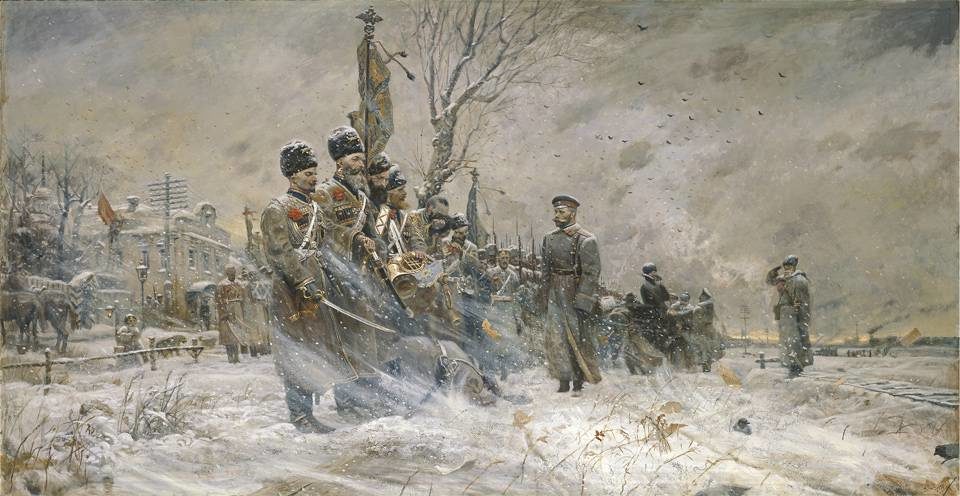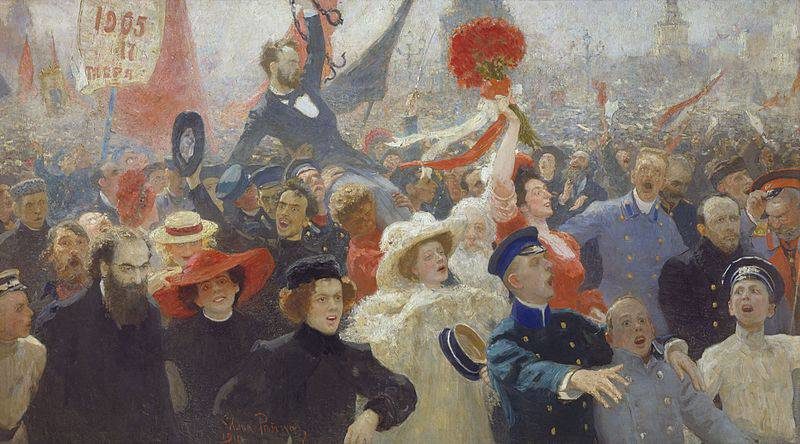The story goes that a peaceful delegation of workers and peasants spontaneously marched to the palace, having decided to ask the Tsar for help, bringing to the Tsar-Father 'their needs and longings.'
Instead of listening to them, the Tsar unleashed his Imperial Guard and gave orders for them to fire upon the unarmed civilians.
1000s of people died. The Tsar proceeded to squelch all the requests of the common people.
In reality, though, this is a highly romanticized - and highly inaccurate - representation of the historical reality, which is, according to Orthodox England:
In the absence of the Tsar from St Petersburg (because of the almost successful assassination attempt on him and his family three weeks before), a violent mob (and not 'peaceful and unarmed', as the Western propaganda goes), burning and looting vehicles and other property revolted on Bloody Sunday in 1905.While stories always represent Nicholas II as a cruel, unfeeling leader, all evidence points to the contrary. Always, the Tsar was heartbroken when violence broke out. On the night of Bloody Sunday, he wrote.
"A heavy day! In Petersburg there were serious disorders as a result of the workers' desire to reach the Winter Palace. The guard had to shoot in various areas of the city, and there were many killed and wounded. Lord, how painful and heavy!"Among the first questions people ask very piteously is this one: if the Tsar didn't actually want people to be shot, and cared about his people, why didn't he just march out if the Winter Palace and greet the demonstrators? Why didn't he just listen to them?
Fact Check 1: The Tsar WASN'T in the Winter Palace.
In fact, he wasn't even in St. Petersburg at all. Nicholas II had stayed in his summer home, kilometres away. His family was still shaken and recovering from a recent assassination attempt by revolutionary terrorists.
The police authority had told Nicholas II that there was nothing to worry about; that while workers were striking, there was no danger of tension in the city.
Sviatopolk-Mirsky, the recently appointed Minister of Internal affairs, who often worked behind the back of the Tsar to advance a liberal agenda, deliberately withheld the information about the upcoming march from the Tsar:
According to Ortho Christian:
the Minister of Interior Affairs reassured himself and others with the words that it would be enough to explain to the people that the Tsar was not in the capital, and they would peacefully disperse...Perhaps, if the Tsar had been in the city, the dimensions of the tragedy would have been substantially decreased, for the workers were, indeed, marching to a Tsar they loved and trusted.
On the evening of January 8, 1905, Sviatopolk-Mirsky came to Tsarskoe Selo and reported on the situation in the capital to the Tsar.
He assured him that despite the enormous number of striking workers, the situation does not merit serious caution;
he did not say a single word about the upcoming march of workers to the Winter Palace, the calling of army battalions to the capital, and the plans to oppose the demonstration using the armed forces.
However, the liberals in the government, the traitorous politicians, and the revolutionaries at large knew it was necessary to create a rift between the Tsar and his faithful people in order to make revolution possible; thus, the Tsar was consistently misinformed and misrepresented by his officials and revolutionaries.
Fact Check 2: The 'peaceful' demonstrators were first to shoot at the Imperial Guard
Despite the rumours of unwarranted violence on the side of the Imperial Guard, the first to open fire were actually the protestors.
Of course, the workers participating in the march were unarmed, but among them there were plenty of well-armed revolutionaries who had become very well versed in violence over the years of terrorist attacks that they waged in the name of the 'Coming Revolution.'
Members of the Eserov party, a group of radical armed revolutionaries that committed numerous terrorist acts in Russia, started shooting at soldiers. It is easy to imagine how violence ensued.
While there were some examples of callousness on the side of the guard, there were also generals who did everything to prevent bloodshed and stop the havoc.
People threw stones, sticks, and pieces of ice at his men, showering them with insults. Litke, however, restrained his men and preferred to retreat to a secluded area, not attempting to solve the problem with force.Fact Check 3: The March was not a spontaneous populist movement. Revolutionaries had planned the march...and violence was part of their plan.
He was not able to clear out Nevsky Prospect right away, breaking up the crowd with rifle butts "due to their stubbornness and animosity," as he wrote in his report.
Especially aggressive was the crowd that gathered by the gate of Alexandrov Park, where they shouted insults at the guard, yelled, whistled, and at the warnings shouted, "Shoot us."
After repeated peaceful attempts and three warning trumpets given with pauses in between, shots were fired, the crowd scattered, leaving around thirty people dead and wounded.
Despite the ubiquitous portrayal of the marchers as innocent, peaceful people who spontaneously decided to ask the Tsar for help, the march was strategically organized by revolutionaries with the specific goal of sparking a violent clash with the authorities. According to Orthodox England:
It was led by a renegade, twice-married priest, Fr George Gapon, who hanged himself the next year, when it was discovered that he was in fact a secret agent.The necessity for a crisis to be concocted and exaggerated in order to create an environment conducive to ultimate revolt was discussed in September 1904 in Paris, at a conference (which was incidentally funded by Japanese money).
While some of the strikes that led to Bloody Sunday were indeed spontaneous, there were documented cases of activists appearing at factories and forcing people to strike.
Fr George Gapon, who came up with the original plan to march on the Tsar, helped put together a document of demands from the Tsar. Many of the demands were completely unrealistic and simply impossible to satisfy at a time when the country was torn by the Russo-Japanese War.
And although the purpose of the march is often described as a humble request for help, it was actually a demand for unquestionable, complete submission from the Tsar...or else....
Here's what Gapon told his followers:
And what if the Tsar does not accept the petition, then what will I do? I will raise a red flag, which means that we do not have a Tsar, that we ourselves must fight for our rights..."The Leftist powers were thrilled with the occurrence and immediately began framing it as "a shooting by the Tsar at a peaceful demonstration."
There is a peaceful march for you!
It is appropriate to note here, as a prelude to the next story, that one of the columns that marched on January 9 was revolutionary, plain and simple, carrying not portraits of the Tsar, but red flags.
Though the revolutionaries professed to want 'political reforms,' nothing of the sort appeased him. They did not need political reforms, they needed "great upheavals" as a Russian politician, Pobedonostev, later said of the revolutionaries.
Fact Check 4: The Casualty Numbers have been systematically and grossly exaggerated
Here is what Ortho Christian writes:
According to official statistics, there were 128 people killed in all (including police), and 360 wounded (including guard and police).In Conclusion
According to the Bolshevik historian V. Nevsky, who was a witness to the events of January 9, 1905, there were from 150 to 200 people killed.
Meanwhile, certain authors (for example, Edward Radzinsky), and textbooks still write that there were thousands of victims.
Though the Tsar systematically did everything in his power to prevent bloodshed, the use of Bloody Sunday as 'proof' of his callousness has become so ingrained into the public consciousness that saying anything to the contrary is often considered to be a sign of ignorance.
According to OrthoChristian:
No one cared about the meeting that the Tsar then had with the workers, about the large sum of money paid to the families that suffered on that day (50,000 rubles, the equivalent of just less than $600,000 today).
Nor did anyone care about the government commission he formed to attend to the workers' needs, nor that in 1906 the periodical Byloe (What Was) (No.1) printed an article with a truthful and thorough account of the events of January 9, 1905.
Let's hope that at least now there are people who want to know the truth about those events.





Reader Comments
The main event is cosmic from which you are being very craftily distracted. Pay no attention to the man behind the curtain.
As Solare says, history repeats... Evil, manipulative people continue using their dirty tricks... But this time we won't let them win!
It appears to me that Clint has no soul, that is why he doesnt understand how terrible the crime was. Good people dont understand manipulation, because its completely outside their world. That is why the tsar was victim of people who only know how to destruct (yes they couldn't even govern). The names of the revolutionairies should indeed made public, so people can spit on their graves.
From thin air, this article claims the "revolutionaries" were the first to open fire, but how about a bit of proof. Story says "revolutionaries"
planned the march. Well, someone had to. You can't fill the streets with many thousands of unhappy people at a given time without someone planning such an event. And in the same breath, the story cites this Father Gapon, who was outed as a police agent after the march. He was involved in agitating the people for years, posing as a priest.And the Tsar wasn't the "victim" of the people. He stayed in power until 1917. After this, he dissolved the Duma, the only legislative assembly people had, even though it was rubber-stamp. The "people" didn't kill Nicholas and his family, either. That was done by Communist Party executors on the order of the government.